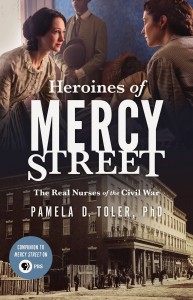Writing The Book That Accompanies a Television Show, or What It’s Like to Be the Toy in the Happy Meal
 There are two questions I can count on being asked after someone sees my writing resume: “Did you get to interview Matt Damon?” and “What’s it like to write a book that’s tied to a television show?”
There are two questions I can count on being asked after someone sees my writing resume: “Did you get to interview Matt Damon?” and “What’s it like to write a book that’s tied to a television show?”
The answer to the first question is simple–no. (Though if you catch me on a good day, I might tell you the “sexiest man alive” story, complete with hand gestures.) The short answer to the second one is “Not as glamorous as you might think.”
I’ve now written two works of historical non-fiction tied to television programs, one for the History Channel and one for PBS. While the two experiences were very different, there are some elements that I now believe are part of the package:
- Carryout pizza.
- From the perspective of the television team, a companion book is an add-on–the adult equivalent of the Disney-themed toy in Happy Meal. As a result, even though the television series will have been in development for months if not years, the time allotted for researching and writing the book will be very, very short. I received the first email about writing Heroines of Mercy Street on July 3 of last year. We agreed on a deal on July 15. I turned in the final revisions on the book on October 18. (I’ll let you do the math. The correct answer is “not long enough”.)
- Long workdays are inevitable. Squeezing a year’s worth of work into a few months doesn’t mean that you aren’t putting in the hours; you’re just putting them in over a shorter span of time. (Word to the wise: At some point halfway through the book you will be tempted to calculate how much you are making per hour. Don’t.)
 At least twice over the course of the project, you will hit the wall and have to take an unintended day off. This is a good thing, though it may not feel like it at the time. Read a novel. Go for a walk. Binge-watch a television show. Make a pot of homemade soup. Spend time with Your Own True Love.
At least twice over the course of the project, you will hit the wall and have to take an unintended day off. This is a good thing, though it may not feel like it at the time. Read a novel. Go for a walk. Binge-watch a television show. Make a pot of homemade soup. Spend time with Your Own True Love.- All books are collaborative to some extent, but television companion books are more collaborative than most because the process of creating a television series is inherently collaborative. Conference calls, copying everyone on emails, and multiple layers of approval are normal. For someone accustomed to working alone in her study with her cat, this takes getting used to.
- Television production teams are incredibly generous with their research. (Another result of television’s collaborative culture.) You still have to do your own research because your purposes are different, but their work provides a wonderful starting point—it’s the difference between diving into the pool off a springboard and wading in at the shallow end.
- The book needs to stand on its own, but it is fundamentally shaped by the television series that inspired it. In the case of Heroines of Mercy Street, that meant that I looked at the broader experience of Civil War nurses through the lens of the real life Union hospital that the producers of Mercy Street chose as the setting for the series. Focusing on Mansion House Hospital in Alexandria and the nurses who passed through it gave me the narrative structure for the book and defined its geographical range. It also meant that some parts of the story didn’t get told as thoroughly as they deserved: the fascinating story of nurses in the Confederacy, for example, was limited to a brief epilogue.
- Your book will ride the tail of the television show in unexpected and exciting ways. It is thrilling to see your book on the screen at the end of every episode.
Would I do it again if given the chance–long hours, short deadlines, and all? Assuming the timing worked and the topic caught my imagination, in a heartbeat.
—
Pamela D. Toler is a freelance writer with a PhD in history and a fascination with historical figures who step outside the constraints of their time. Her official field is South Asian history, but on any given day she could be writing about Siberian reindeer hair embroidery, World War I recruiting posters, pyramid cults, the mud mosques of West Africa, the first translation of the Arabian Nights, Napoleon’s invasion of Egypt, or tough broads from the past.
She is the author of a middle-grade biography of Matt Damon, Mankind: The Story of All of Us, The Everything Guide to Socialism, and most recently Heroines of Mercy Street: The Real Nurses of the Civil War.
BUY HEROINES OF MERCY STREET HERE
Find out more about Pamela on her website http://www.historyinthemargins.com/
Category: Contemporary Women Writers, On Writing






























